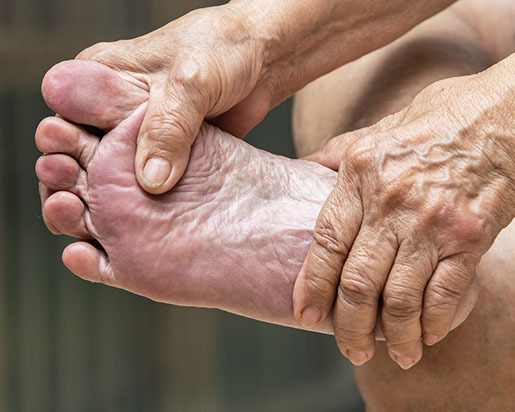
Diabetic Foot Care Jacksonville FL
According to the American Diabetes Association, about 15.7 million people (5.9 percent of the United States population) have diabetes. Nervous system damage (also called neuropathy) affects about 60 to 70 percent of people with diabetes and is a major complication that may cause diabetics to lose feeling in their feet or hands.

Effects
Diabetes is a lifelong chronic disease that is caused by high levels of sugar in the blood. It can also decrease your body's ability to fight off infections, which is especially harmful in your feet. When diabetes is not properly controlled, damage can occur to the organs and impairment of the immune system is also likely to occur.
Symptoms
With damage to your nervous system, you may not be able to feel your feet properly. Normal sweat secretion and oil production that lubricates the skin of the foot is impaired, which can lead to an abnormal pressure on the skin, bones, and joints of the foot during walking and other activities. This can even lead to the breakdown of the skin of the foot, which often causes sores to develop. If you have diabetes, it is important to prevent foot problems before they occur, recognize problems early, and seek the right treatment when a problem does happen.
Basic Care
- Always keep your feet warm.
- Don't get your feet wet in snow or rain.
- Keep feet away from heat (heating pads, hot water pads, electric blankets, radiators, fireplaces). You can burn your feet without knowing it. Water temperature should be less than 92 degrees. Estimate with your elbow or bath thermometer (you can get one in any store that sells infant products).
- Avoid smoking or sitting cross-legged. Both reduce blood flow to your feet.
- Avoid soaking feet.
- Don't use antiseptic solutions (such as iodine or salicylic acid) or over-the-counter treatments for corns or calluses.
- Don't use any tape or sticky products, such as corn plasters, on your feet. They can rip your skin.
- Use a nail file or emery board to shape toenails straight across. Avoid cutting the corners. If you find an ingrown toenail, contact our office for treatment.
- Use lotion to moisturize feet, keeping skin soft and moist - ensuring not to put any lotion between your toes.
- Wash your feet daily with mild soap and warm water.
- Wear loose socks overnight.
- When drying your feet, pat each foot with a towel and be careful between your toes.
- Purchase shoes that are comfortable and do not need to be "broken-in" . Be sure to thoroughly check how the shoe fits - in width, length, back, bottom of heel, and sole. Avoid pointed-toe styles and high heels. Look for shoes with leather upper material and ample room for toes. Use new shoes for minimal time periods - two hours or less at a time.
- Don't wear the same pair of shoes everyday. Examine the inside of each shoe looking for foreign objects, protruding nails, or any rough spots inside before putting them on. Be sure not to lace shoes too tight or loose.
- Be sure to wear clean, dry socks everyday and always wear socks with shoes. Avoid torn or wrinkled socks. Look for thin, cotton socks in the summer as they are more absorbent. Look for socks with square-toes as they will not squeeze toes. Avoid stockings with elastic tops or garters.
- Never wear sandals or thongs (flip-flops) and never go barefoot, indoors or out.
- In the winter, wear warm socks and protective outer footwear. Avoid getting your feet wet in the snow and rain and avoid letting your toes get cold.
- Don't file down, remove, or shave off corns or calluses yourself.
Normal nerves allow people to sense if their shoes are too tight or if their shoes are rubbing on the feet too much. With diabetes, you may not be able to properly sense minor injuries, such as cuts, scrapes and blisters-all signs of abnormal wear, tear, and foot strain.
Prevention
Diabetes can be extremely dangerous to your feet, so take precautions now. You can avoid serious problems such as losing a toe, foot, or leg by following proper prevention techniques offered by your podiatrist. Remember, prevention is the key to saving your feet and eliminating pain.